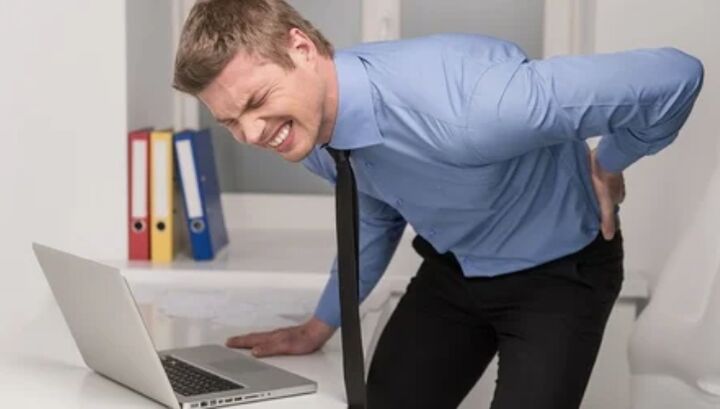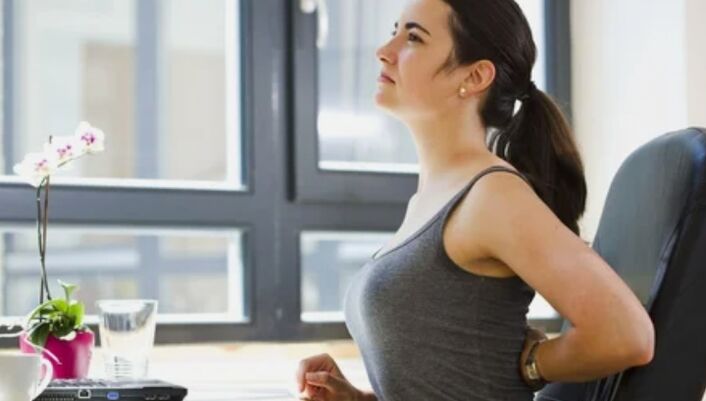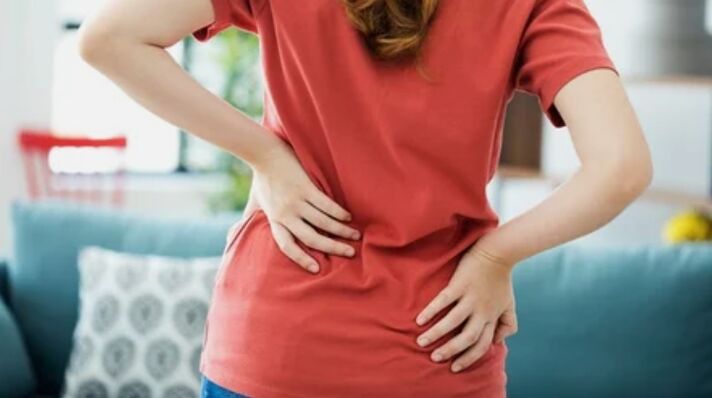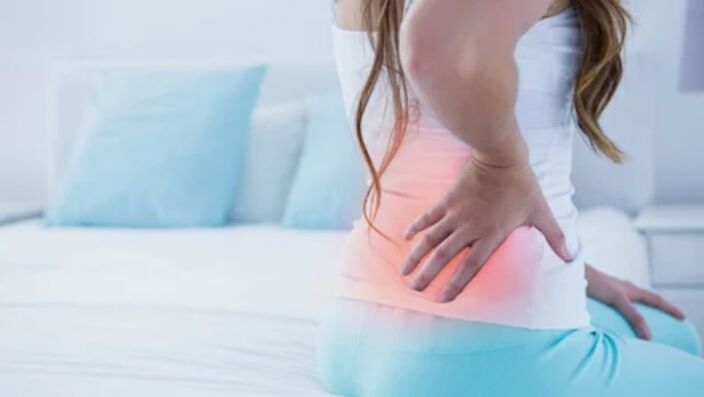Almost all people are confronted with the appearance of the spine.With the help of painkillers, the majority of the population does not even ask why it hurts to the audience, the drafts, or the consequences of stretching, attributing to the back, negative manifestations.Meanwhile, the painful syndrome (BS) may be alarming sign for the appearance of severe pathologies.

In different parts
Back pain is different.
Of them can be distinguished:
- Fight.Different on the frequency.
- Growing.In the process of pathological conditions, the intensity of unpleasant manifestations occurs.
- Dagger.The consequences of emergency situations.
- In the form of fires.These are recorded in the case of impaired functionality of the spinal column.
- Constant or monotonous.
In addition, back pain can be two types:
- Projected.It spreads along the nerve fibers.Can radiate to remote parts of the body.
- Reflected.It occurs in the work of the internal organs during defect errors.
On the right side
Many circumstances explain why the back hurts on the right.These:
- The result of hypodynamia, which causes the abdominal muscles to lose their elasticity and elasticity, while the total load is laid on the spinal column;
- injuries and bruises of soft tissues;
- Performing physical work in an unnatural position (with uneven load).
In addition to natural factors, the back of the back may be caused by the disease of the internal organs and the muscle bone system.
This symptom may be part of the clinical picture of the following diseases:
- Respiratory disease.With inflammation of pneumonia (right pneumonia on the right), in addition to back pain, the patient also complains about dry cough, general weakness and body temperature index.
- Observe the BS on the right with pleurisy.It is accompanied by discharge and difficulty in breathing.
- Pathology of liver and gallbladder.BS distinguishes the duration of the current.To stop, painkillers or inhibitions are used.The clinical picture is complemented by signs of intoxication (nausea, vomiting, violation of the decanation law).
- Gastric intestinal diseases.In the case of pancreatitis or gastritis, the pain syndrome is usually localized on the left, but often radiates to the right.
- Urine diseasesThey are declared with extended or stupid pain.It occurs in the background of frequent urination, with the appearance of red blood cells (blood) in the urine.A distinctive feature is that a sick person does not find a convenient body position to reduce back pain.
- Appendicitis.In addition to the abdominal discomfort, the patient notes that the back hurts on the right.Other symptoms are nausea and vomiting reflex appearance, increase in body temperature index, and general breakdown.
- Gynecological pathologies.The inconvenience on the right is recorded due to ectopic pregnancy, inflammation of the appendices or the increase in cystic ovarian seals.
- Osteochondrosis.The pain can be localized on the right and left.It is accompanied by stiffness of movements and increases with physical work (especially when someone is done first).In advanced forms, the irradiation of the fingers is observed with their numbness.
On the left side
Localization of left back pain can be the most important or complementary symptom in the clinical image of many diseases.

In the following cases, you may have:
- Disease of the spinal column.The patient most often complains that the back pain is painful when osteochondrosis, intercostal neuralgia or nerve stings.The clinical picture is complemented by the stiffness of movements, the radiation of the upper limb, and the loss of the sensitivity of the fingers.
- Stomach and bowel disease.The symptoms of pain are complemented by nausea, vomiting, stool disorder and increased gas formation.These signs appear with pancreatitis, intestinal chole, cholecystitis.
- Cardiological diseases.The acute painful syndrome from the back is a characteristic sign of myocardial infarction from the back of the ribs, the shortness of breath and behind the sternum.
- In the bronchi and lungs, BS can be observed with pneumothorax, pleurisy, bronchitis or pneumonia.It can increase during inhalation and reduce it during exhalation.
In the lower back of the back
The lumbar region begins from the place where the ribs end and end with coccyge.Most often, patients who seek medical help with back pain complaints mean the lower back.
Causes of lumbar pain are the following conditions:
- 90% of all cases of lumbar pain are explained by violation of the functionality of the spinal column (osteochondrosis, hernia between the vertebrae, skoliosis, radiculite).These circumstances are characterized by symptoms in the form of sudden shots.
- 6%at the lower back of the back is the result of violation of the urinary tract.This property is manifested in the formation of pyelonephritis, cystitis, glomerulonephritis or in the kidneys in the formation of calculation (stones).
- 4% disease of other internal organs (stomachs, intestines).
In the area of the blades
One can feel pain in the scope area in different places of localization:
- The pain syndrome is localized under the blades.This nature of BS is observed in the presence of ulcers and erosion in the stomach.At the same time, the main epicenter of negative sensations is concentrated in the epigastric zone and the irradiation gives the shoulder blade.
- Compression of chest, sore and stupid pain often causes osteochondrosis or myositis.
- When the back hurts between the blades, it is most likely to be assumed to localize intercostal neuralgia (when it occurs in the form of BS fireplace).In the development of pneumonia, it enhances painful feelings at the peak of cough and sigh.
- BS is most often manifested as a post -traumatic consequence in the shoulder blade.Symptoms of negative feelings increase when the upper limbs move.

Along the spine
The cause of back pain along the spine may be the following conditions:
- Lumbalgia.It manifests itself in an acute way after raising the weights.
- Stoop, skoliosis or kyphosis causes uncomfortable feelings that are expressed by pulling or pain by BS.
- The hernial protrusion between the vertebrae leads to compression of the nerve roots, causing a burning sensation along the spinal column.In this case, there is a loss of rear sensitivity.
- Cervical and chest osteochondrosis leads to changes in spinous processes of the vertebrae, which are the result of constant damage to their nerve endings.This causes back pain and stiffness in movements.
- Injuries cause acute and sharp pain syndrome.In the case of damage to the spinal cord, the sensitivity of the lower limbs occurs.
- Joint inflammation is characterized by a gradual increase in discomfort, crunching and clicking on the vertebrae.
- Endometriosis and adnexitis cause the spinal discomfort due to anatomical arrangement of female reproductive organs (in the lower abdomen).
In the lower back of the back
The lumbosacral class is most often loaded due to severity, prolonged walk or inadequate rise in the sitting position.But these situations only partially explain why the back hurts in the lower back.
The inconvenience occurs as follows:
- Pathological changes in the spine (arthrosis, osteochondrosis, hernia protrusion between the vertebrae);
- after injury to saccyx or coccyx;
- In case of violation of posture (skoliosis or lordosis).
Sacred class pain appears in diseases of genitourinarinal gurrice, constipation, cholecystitis or gastritis.In women, this symptom may indicate pregnancy or menopausal.Occasionally, this indicates the beginning of the menstrual cycle.
Grieviness in the back of the post -sleep
Occasionally, after a night's rest, you notice severe fatigue and breakdown.

Most often the following factors contribute to this:
- Incorrect organization of the berth (too hard or soft mattress);
- increased physical activity or large quantities of work during the day;
- devastating changes with impaired functionality of the vertebrae and plates;
- age -related changes in the cartilage tissue of intervertebral discs;
- consequences of injuries;
- Inflammation in the internal organs of the abdominal cavity.
Pain in the muscles
In the vertebrae and intervertebral discs, pathological processes change the structure of the bones and cartilage.As a result, muscles and tendons have fascia surge.This leads to the body reacting with the occurrence of BS.
In some cases, it should be noted that the back pain is painful after a long stay during the draft or hypothermia.These two factors contribute to the manifestation of myositis, in which the pain is localized in the surface muscles.This is a distinctive feature of the inconvenience of palpation or when the patient tries to turn or decide the body.Occasionally symptoms occur after jerks and bruises.
In muscle groups, painful syndrome is often due to intense training athletes.In this case, overloaded muscle fibers lose their elasticity, the seals appear in them, which are detected during palpation.
The causes of illness
The back pain is diagnosed with various diseases.
They belong to:
- pathological processes in the spine (hernia, spondylitis, arthralgia, radiculitis);
- myocardial infarction, aortic aneurysm;
- stomach and intestinal disease (pancreatitis, colitis);
- Calculus formation in the kidneys, cholecystitis, liver.
However, the etiology of all diseases are different, which are taken into account when choosing treatment tactics.
Degenerative pathologies
Degenerative changes occur in cartilage and bone tissue.Violation of morphological structure causes dystrophy, which is why osteochondrosis, spondylosis or spondil -arthrosis occurs.
The provocative factors of destructive changes are distinguished:
- Violation of metabolism, which causes inadequate nutrients in the discs between the vertebrae;
- Limited intake of charity trace elements in the body;
- High loads and injuries;
- Malfunction of the endocrine system;
- Bad habits such as smoking and excessive addiction to alcoholic beverages;
- Hypodynamia and sedentary lifestyle.
Inflammatory diseases
Diseases leading to inflammation of the spine can be independently occurring and may be the result of complications of pathologies.They are recorded in rare cases, but are a serious threat to the patient's health.

In the focus of inflammation, it may be localized in different parts of the vertebrae:
- In the first phase, spondylitis, dycitis or spondylodiscite are most often diagnosed;
- The back localization provokes the formation of osteomyelitis, spondylitis or paravertebral abscess;
- If the spinal canal is infected, the inflammation is presented by the development of an abscess or epidurite.
In addition, the tissues of the spine can be caused by tuberculosis, brucellosis, trichinellosis (various helmintas).
This type of pathology is characterized by a sharp analgesic attack by muscle groups, which is difficult to eliminate painkillers.The clinical picture can be complemented by associated symptoms, such as cramping body temperature and loss of sensitivity in certain areas of the spinal column.
Miofascial syndrome
Myofascial syndrome has a chronic orbit with the formation of gaskets in the muscle tissue in the form of pain (trigger) points.This causes not only severe discomfort, but also to reduce motor activity, which results in the patient rapidly tired, even less physical activity.
The likelihood of developing myofascial syndrome is often increased in the following situations:
- osteochondrosis, spondylarthrosis, injuries and bruises;
- Diagnosis of skoliosis or flat legs;
- If work is related to repeating stereotypical movements;
- In case of violation of the psychoemotic condition (if this occurs with increased muscle stress).
In clinical practice, they are important in the state of trigger points.Are active or latent.
With this in mind, they are classified as follows:
- Acute form.The trigger dots are active and cause discomfort when they try any movement.
- Subakut.Negative manifestations disappear at rest.
- Chronic.A latent condition only causes insignificant discomfort in the right area.
In addition
- Primary starters are formed due to muscle damage;
- The secondary is fixed by violation of the functionality of the joints and somatic organs.
Physiological reasons
Another group of other physiological causes of pain in the muscle pan is called a household.They do not require treatment and do not require themselves after a little rest.
They belong to:
- hard physical work for a long time;
- Weakening or fatigue of the body;
- Incorrectly selected pose for night rest or to perform monotonous actions during work;
- Poor organization of the place needed for night sleep;
- A poorly selected mattress or pillow.
You need to consult a doctor to determine the cause of the back pain, as this may require a number of diagnostic measures.This determines the tactic of the treatment process, which does not allow the disease to be transformed into a neglected form.






















